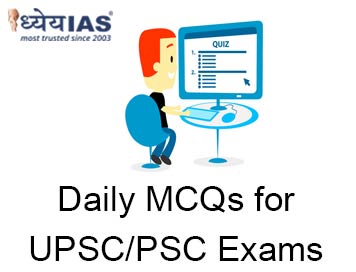Home > Daily-mcqs
Daily-mcqs 21 Apr 2025

Q1:
Consider the following statements regarding the NISAR mission: How many of the above statements are correct?
A: Only two
B: Only three
C: All four
D: Only one
Answer: B
Explanation:
Statements 1, 2, and 4 are correct. NISAR is equipped with dual-band radars: NASA’s L-band and ISRO’s S-band, enabling it to measure minute surface changes, including those related to glaciers, forest cover, and tectonic activity. It will be launched by ISRO using a GSLV rocket. The collaboration showcases India-US partnership in space.
However, Statement 3 is incorrect: NISAR can detect changes as small as one centimeter, not one meter. This high resolution is what makes it a powerful tool in disaster monitoring and climate studies.
Q2:
The manuscripts of which of the following texts were recently added to UNESCO’s Memory of the World Register in 2024–25?
A: Arthashastra and Ramayana
B: Bhagavad Gita and Natyashastra
C: Yoga Sutras and Manusmriti
D: Tolkappiyam and Jataka Tales
Answer: B
Explanation:
The Bhagavad Gita and Natyashastra manuscripts, preserved at the Bhandarkar Oriental Research Institute, were the latest additions from India to the UNESCO Memory of the World Register.
Q3:
Consider the following statements: Statement I: The Andhra Pradesh government has approved a reservation framework that classifies Scheduled Castes into groups based on sub-caste-specific backwardness. Which of the following is correct?
Statement II: This framework is based on the idea that all SC sub-castes are equally represented in education, jobs, and political institutions.
A: Both Statement-I and Statement-II are correct, and Statement-II explains Statement-I
B: Both Statement-I and Statement-II are correct, but Statement-II does not explain Statement-I
C: Statement-I is correct, but Statement-II is incorrect
D: Statement-I is incorrect, but Statement-II is correct
Answer: C
Explanation:
Statement I is correct: The Andhra Pradesh ordinance introduces sub-categorization of SCs based on social, educational, and economic backwardness to ensure equitable reservation.
Statement II is incorrect: The move stems from the acknowledgment that all SC sub-castes are not equally represented—some communities have benefited more than others. Hence, the ordinance aims to correct this imbalance, not assume equal representation.
Q4:
Consider the following statements: Statement I: Paste fill technology contributes to sustainable coal mining practices. Which of the following is correct?
Statement II: It utilizes industrial by-products like fly ash and overburden to fill underground voids.
A: Both statements are correct, and Statement II explains Statement I.
B: Both statements are correct, but Statement II does not explain Statement I.
C: Statement I is correct, but Statement II is incorrect.
D: Statement I is incorrect, and Statement II is correct.
Answer: A
Explanation:
The reuse of industrial waste (fly ash, overburden) contributes to the eco-friendly nature of the mining method.
Q5:
In which of the following cases did the Supreme Court mandate the playing of the national anthem in cinema halls, later criticized for judicial overreach?
A: Kesavananda Bharati v. State of Kerala
B: Shyam Narayan Chouksey v. Union of India
C: Indira Gandhi v. Raj Narain
D: Maneka Gandhi v. Union of India
Answer: B
Explanation:
In 2016, the Supreme Court, in the Shyam Narayan Chouksey case, directed all cinema halls to play the national anthem before screening films. The order was criticized for lacking statutory basis and interfering with individual autonomy, prompting debates on judicial overreach. The directive was later modified.